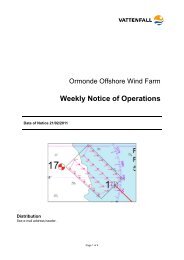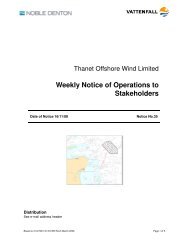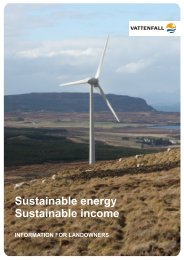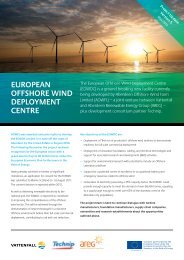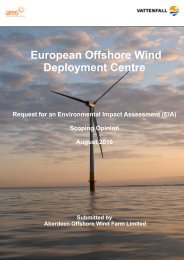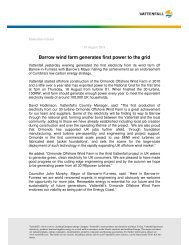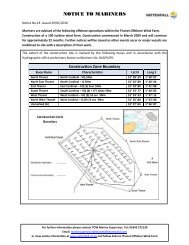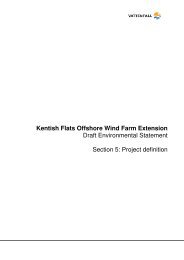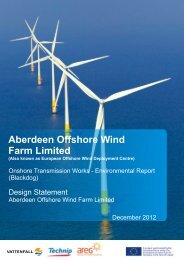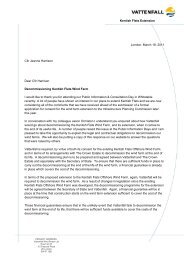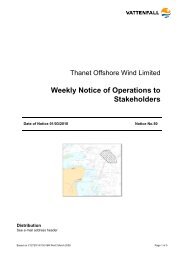Hydro power (PDF 307 kB) - Vattenfall
Hydro power (PDF 307 kB) - Vattenfall
Hydro power (PDF 307 kB) - Vattenfall
You also want an ePaper? Increase the reach of your titles
YUMPU automatically turns print PDFs into web optimized ePapers that Google loves.
<strong>Hydro</strong> <strong>power</strong>
The Energy Triangle – <strong>Hydro</strong> <strong>power</strong><br />
In supplying society with its energy needs, a balance<br />
must be struck between three key dimensions:<br />
competitiveness, security of supply, and environment<br />
and climate. In other words: How much are we ready<br />
to pay for our energy How much energy does society<br />
need And what impact on the environment are we<br />
willing to accept This ”energy triangle” illustrates the<br />
pros and cons of each energy source and the need<br />
for a mix of complementary energy sources in <strong>power</strong><br />
generation. Currently, no single energy source is<br />
optimal from all dimensions, there are pros and cons<br />
for all of them.<br />
Competitiveness<br />
Energy is a fundamental input to economic activity, and thus to human welfare and<br />
progress. The costs of producing energy vary between different energy sources and<br />
technologies. A competitive energy mix will keep overall costs as low as possible given<br />
the available resources.<br />
<strong>Hydro</strong> <strong>power</strong> has no fuel costs and competitive generation costs. Constructing a<br />
new plant requires a substantial investment, but the economic life of a plant is<br />
long.<br />
Security of supply<br />
Fuel shortages and unreliable electricity systems cause societal and economic<br />
problems. Securing supply means guaranteeing that primary energy is available, and<br />
that delivered energy is reliable, essentially 100 per cent of the time. This is a major<br />
political and technical challenge.<br />
<strong>Hydro</strong> <strong>power</strong> plants provide large-scale and stable electricity generation which<br />
can often be controlled domestically. But sustained high generation levels are<br />
dependent on precipitation. <strong>Hydro</strong> <strong>power</strong> also functions as balancing <strong>power</strong>,<br />
since capacity can be rapidly changed to compensate for differences in<br />
generation and consumption in the mains supply.<br />
Climate and environment<br />
All energy sources have environmental impact during their lifecycles. Combustion of<br />
energy sources, particularly fossil fuels, generates CO 2 emissions and contributes to<br />
global warming. In the long run, emissions from electricity generation will need to be<br />
close to zero if greenhouse gas levels in the atmosphere are to be stabilized.<br />
<strong>Hydro</strong> <strong>power</strong> is a renewable energy source that causes almost no emissions that<br />
impact the climate or the environment. However, <strong>power</strong> plants are a significant<br />
encroachment on the landscape and impact river ecosystems. A <strong>power</strong> plant<br />
may also affect animal and plant life in the vicinity.<br />
2
Table of Contents<br />
1. <strong>Vattenfall</strong> and <strong>Hydro</strong> <strong>power</strong> ................................................................................... 4<br />
<strong>Vattenfall</strong>’s hydro <strong>power</strong> operations ...................................................................... 4<br />
<strong>Vattenfall</strong>’s hydro <strong>power</strong> going forward ................................................................. 4<br />
2. The History of <strong>Hydro</strong> <strong>power</strong> .................................................................................. 5<br />
Sweden – an example of the significance of hydro <strong>power</strong> .................................... 6<br />
Global and local considerations conflict ................................................................ 6<br />
3. How a <strong>Hydro</strong> Power Plant Works ......................................................................... 7<br />
<strong>Hydro</strong> <strong>power</strong>’s significance as balancing <strong>power</strong> ................................................... 8<br />
Long useful life and low operating costs ............................................................... 9<br />
Environmental consideration and fish conservation .............................................. 9<br />
4. <strong>Hydro</strong> <strong>power</strong> in Europe ........................................................................................ 10<br />
<strong>Hydro</strong> <strong>power</strong> in European countries .................................................................... 10<br />
Safety and environmental considerations ........................................................... 11<br />
New technology brings more hydro <strong>power</strong> to Europe ......................................... 11<br />
5. The Future of <strong>Hydro</strong> Power ................................................................................. 12<br />
Great potential for small-scale hydro <strong>power</strong> ........................................................ 12<br />
Pumping <strong>power</strong> increases system reliability........................................................ 12<br />
Ocean waves are an untapped resource ............................................................ 13<br />
Tidal energy – a blend of old and new technology .............................................. 13<br />
Osmotic <strong>power</strong> – an innovative idea with great potential .................................... 13<br />
New technologies on the way – but the traditional ones remain important ........ 14<br />
6. Summary ............................................................................................................... 15<br />
3
1. <strong>Vattenfall</strong> and <strong>Hydro</strong> <strong>power</strong><br />
<strong>Hydro</strong> <strong>power</strong> is a renewable energy source that is economically attractive,<br />
provides security of supply and has low levels of CO 2 emissions. <strong>Vattenfall</strong><br />
has century-long roots in hydro <strong>power</strong> and continues to hold a leading<br />
position in Sweden. <strong>Vattenfall</strong> is committed to hydro <strong>power</strong> and intends to<br />
explore growth options through acquisitions in Central and Western<br />
Europe.<br />
<strong>Vattenfall</strong>’s hydro <strong>power</strong> operations<br />
<strong>Vattenfall</strong> owns and operates more than one hundred hydro <strong>power</strong> plants, most of<br />
which are located in Sweden with some in Finland and Germany. <strong>Hydro</strong> <strong>power</strong><br />
accounts for roughly 20 per cent of <strong>Vattenfall</strong>’s total electricity generation and is the<br />
most important renewable energy source in terms of both <strong>Vattenfall</strong>’s production and<br />
the European energy system.<br />
<strong>Hydro</strong> <strong>power</strong> has played an important role in <strong>Vattenfall</strong>’s history. When <strong>Vattenfall</strong>’s<br />
predecessor, the State Power Board of Sweden, was founded in 1909, it was tasked<br />
with managing the Swedish State’s investments in hydro <strong>power</strong>. Sweden’s many rivers<br />
and streams comprised an excellent source of energy for Swedish industry, one which<br />
grew at a record pace in the early 1900s. Since then, hydro <strong>power</strong> has played a vital<br />
role for both <strong>Vattenfall</strong> and for Sweden.<br />
<strong>Vattenfall</strong> also operates a number of fish farms, including those in Indalsälven and<br />
Luleälven, to compensate for the impact that the company’s <strong>power</strong> plants have on fish<br />
stocks in Swedish rivers. <strong>Vattenfall</strong> is Sweden’s largest fish farmer, releasing nearly<br />
two million salmon, whitefish and sea trout fry into Swedish rivers each year. For a full<br />
list of <strong>Vattenfall</strong>’s hydro <strong>power</strong> plants, please see the production site at<br />
www.vattenfall.com/<strong>power</strong>plants.<br />
<strong>Vattenfall</strong>’s hydro <strong>power</strong> going forward<br />
<strong>Hydro</strong> <strong>power</strong> is increasingly attractive, particularly in light of the fact that the French<br />
market is currently opening up to competition. As one of Europe’s largest operators,<br />
<strong>Vattenfall</strong> has a clear competitive advantage. <strong>Vattenfall</strong> will continue to keep growth<br />
options open.<br />
<strong>Vattenfall</strong> is investing in modernising and upgrading existing hydro <strong>power</strong> plants, thirty<br />
or so of which will be upgraded between 2010 and 2014. <strong>Vattenfall</strong> is also conducting<br />
a comprehensive dam safety programme. The Abelvattnet <strong>power</strong> plant, in Storuman in<br />
northern Sweden, will be <strong>Vattenfall</strong>’s first newly constructed hydro <strong>power</strong> plant in over<br />
fifteen years.<br />
The share of hydro <strong>power</strong> in <strong>Vattenfall</strong>’s electricity generation is expected to fall to just<br />
over half of its current level by 2030. This is not due to a reduction in hydro <strong>power</strong><br />
generation, but to the fact that hydro <strong>power</strong> is already well developed. Simply put,<br />
there are few opportunities to build more or to expand existing hydro <strong>power</strong> plants as<br />
the demand for electricity rises. Increases in electricity generation will therefore come<br />
primarily from other types of energy.<br />
4
<strong>Vattenfall</strong> invests in the hydro <strong>power</strong> of the future<br />
<strong>Vattenfall</strong> is involved in several research projects on wave <strong>power</strong> in the seas off<br />
Norway and Sweden, and is also following developments in many other countries. In<br />
collaboration with a Scottish company, <strong>Vattenfall</strong> is planning a wave <strong>power</strong> plant off the<br />
Shetland Islands in the Atlantic. <strong>Vattenfall</strong> expects wave <strong>power</strong> to be commercially<br />
viable within ten to fifteen years, and that it will account for approximately eight per<br />
cent of <strong>Vattenfall</strong>’s electricity generation by 2030.<br />
2. The History of <strong>Hydro</strong> <strong>power</strong><br />
<strong>Hydro</strong> <strong>power</strong> is one of our oldest energy sources and has been used for several<br />
thousand years. In India during the Roman Empire and in ancient China, water wheels<br />
were built to operate mills and timber saws. <strong>Hydro</strong> <strong>power</strong> was developed over the<br />
centuries, and was used in the early industrial era to <strong>power</strong> spinning machines and<br />
looms in textile factories in England and other countries. But modern, large-scale hydro<br />
<strong>power</strong> as we know it today first came into being with the invention of the electric motor<br />
and electric generator.<br />
<strong>Hydro</strong> <strong>power</strong> involves harnessing the energy present in the movement of water to<br />
generate electricity. Water movement occurs in many different ways. The movement of<br />
water through its natural cycle creates streams and rivers. Winds and ocean currents<br />
create waves, and the moon’s gravitational force creates tidal flows. <strong>Hydro</strong> <strong>power</strong> can<br />
also be found in the energy created in the mix of fresh and salt water as rivers and<br />
streams flow into the sea.<br />
5
The extraction of potential energy generated by water as it moves through its natural<br />
cycle is generally referred to as ”hydro <strong>power</strong>”. Glaciers and lakes are created through<br />
evaporation and precipitation, and water flows back to the sea via rivers and streams.<br />
In order to harness the energy of running water, watercourses are altered so that the<br />
flow can be controlled and the water can be directed from dams to a lower level via a<br />
turbine. As water from the dam flows through the turbine, the water’s potential energy<br />
is converted to mechanical energy which is then converted to electric energy via a<br />
generator.<br />
Sweden – an example of the significance of hydro <strong>power</strong><br />
<strong>Hydro</strong> <strong>power</strong> played a decisive role in Sweden’s transformation from a poor exporter of<br />
raw materials to a rich country with high-tech, electricity-intensive manufacturing<br />
industries. This industrial development placed enormous demands on the energy<br />
supply, and the Swedish State recognised early on the potential presented by Swedish<br />
rivers.<br />
Sweden became a world leader in the development of large-scale hydro <strong>power</strong> during<br />
the 1900s. The hydro <strong>power</strong> plant in Porjus, opened in 1915, was built to bring<br />
electricity to the ore railway in Northern Sweden and was one of the largest, most<br />
highly advanced hydro <strong>power</strong> projects that had been carried out to date. The 1930s<br />
saw the development of the technology necessary to send electricity over longer<br />
distances, and the major rivers in Northern Sweden could thereby be used in earnest<br />
to process Swedish natural resources such as timber and ore. The Harsprång <strong>power</strong><br />
line was opened in 1952. Running from the Harsprång <strong>power</strong> plant, one of the world’s<br />
largest hydro <strong>power</strong> plants, located outside Jokkmokk, to Hallsberg, nearly 1,000<br />
kilometres to the south, the <strong>power</strong> line linked the entire Swedish <strong>power</strong> network. 1<br />
The inexpensive, secure electricity provided by hydro <strong>power</strong> enabled the emergence of<br />
Swedish base industry and served as the foundation for rapid Swedish growth in the<br />
mid-1900s. The mining industry, iron and steel mills, chemical industries and paper<br />
and pulp mills all developed thanks to their interplay with hydro <strong>power</strong>, and this<br />
remains true today. Sweden’s exports still consist to a great degree of products from<br />
energy-intensive industries 2 , and access to inexpensive, secure electricity is therefore<br />
of great importance to the Swedish economy.<br />
<strong>Hydro</strong> <strong>power</strong> on the whole receives strong support from nearly all sections of society,<br />
and attitudes towards hydro <strong>power</strong> do not appear to be affected to any significant<br />
degree by political orientation, educational level or age. Negative views are generally<br />
targeted at expansion of hydro <strong>power</strong> and usually not at existing hydro <strong>power</strong> plants.<br />
Global and local considerations conflict<br />
Large-scale hydro <strong>power</strong> has very little impact on the climate and environment in the<br />
wider perspective. But hydro <strong>power</strong> does have a major impact on the environment in<br />
direct proximity to the plant and watercourse. The impact of hydro <strong>power</strong> is accordingly<br />
location-specific, which results in distinct conflicts of interest. From a climate<br />
perspective, hydro <strong>power</strong> is a very advantageous type of energy. But for people living<br />
1 For more information about hydro <strong>power</strong> plants please see www.vattenfall.com/<strong>power</strong>plants<br />
2 Statistics Sweden, SCB, Trade in Goods and Services, Foreign Trade<br />
6
near a planned hydro <strong>power</strong> plant and for the adjacent environment, the impact is<br />
more tangible than for almost any other type of energy. Given that large-scale hydro<br />
<strong>power</strong> plants represent a significant encroachment on the surrounding natural<br />
environment, the preservation of unspoiled watercourses has often been an argument<br />
against the expansion of hydro <strong>power</strong>.<br />
Public opinion on hydro <strong>power</strong> has not been entirely positive throughout the hundred<br />
plus years of hydro <strong>power</strong>’s history. Until the 1950s, hydro <strong>power</strong> was viewed as<br />
something positive and a necessary part of a functioning electricity generation system<br />
in countries that possessed the appropriate natural resources. However, in the 1950s<br />
and 60s a counter-movement emerged, including in Sweden. Nearly all Swedish rivers<br />
were developed at that time, and an activist movement gained momentum to preserve<br />
the last unspoiled rivers from development. Despite the location-specific environmental<br />
impact of hydro <strong>power</strong>, protests against its expansion were initiated from throughout<br />
the country.<br />
During recent decades, growing concerns about the greenhouse effect and global<br />
warming have boosted the general public’s perception of hydro <strong>power</strong> and it is now<br />
viewed as part of the solution to the climate change problem. Support for hydro <strong>power</strong><br />
remains essentially strong and intact. The issue is not whether hydro <strong>power</strong> is positive<br />
or negative, but rather how many unspoiled watercourses should be preserved.<br />
3. How a <strong>Hydro</strong> Power Plant Works<br />
Anyone who has ever seen a large waterfall understands the enormous amount of<br />
energy present in rushing water. Harnessing a natural force of this magnitude requires<br />
advanced engineering skill and colossal constructions. Modern hydro <strong>power</strong> plants are<br />
therefore immense structures with dams that may be over one hundred metres high,<br />
huge man-made lakes and turbines weighing hundreds of tonnes. The technology<br />
behind hydro <strong>power</strong> is fairly simple, but taming the <strong>power</strong> of water is a major<br />
challenge.<br />
Utilising water’s natural cycle by harnessing the energy of rivers and streams is the<br />
most common and significant form of hydro <strong>power</strong>. Generally speaking, it works by<br />
using flowing water to <strong>power</strong> a generator that generates electricity. Dams create<br />
reservoirs that allow for greater heights of fall and also serve to regulate energy<br />
withdrawal; i.e., water is stored and used when electricity demand is the greatest. The<br />
water is directed from the reservoir to a lower level through tunnels, passing a turbine<br />
on the way. The type of turbine used depends on the size of the <strong>power</strong> plant, height of<br />
fall and other conditions. The Francis turbine is the most common type, used chiefly in<br />
hydro <strong>power</strong> plants with medium heights of fall. <strong>Hydro</strong> <strong>power</strong> plants with higher heights<br />
of fall (in the Alps and Norway, for example) normally use a Pelton turbine. A generator<br />
then converts the mechanical energy generated by the rotating turbine shaft into<br />
electrical energy, a transformer then increases the voltage and the electricity is<br />
transmitted to the grid.<br />
7
1.Reservoir<br />
Water is accumulated in reservoirs that allow for greater heights of fall. Reservoirs can<br />
also store water to be used when electricity demand is the greatest.<br />
2.Turbine<br />
The water is directed from the reservoir to a lower level through tunnels, passing a<br />
turbine on the way. The turbine shaft is connected to a generator.<br />
3.Generator<br />
The generator converts the turbine's rotary motion into electrical energy<br />
4.Transformer<br />
The transformer adjusts the voltage to a level approprate for the grid<br />
<strong>Hydro</strong> <strong>power</strong> plants are surrounded by various types of dams, pools, infrastructure and<br />
other things necessary to keep a <strong>power</strong> plant running. Various types of research<br />
equipment and research stations are in place, as are fish ladders which make it easier<br />
for migratory fish to pass through the <strong>power</strong> plant. The look and design of hydro <strong>power</strong><br />
plants can vary widely depending on natural conditions, the watercourse where the<br />
plant is built and the surrounding natural environment. A hydro <strong>power</strong> plant built high<br />
on a steep mountainside in the Alps calls for a completely different design than a plant<br />
built in a flat river valley.<br />
<strong>Hydro</strong> <strong>power</strong>’s significance as balancing <strong>power</strong><br />
One problem with electricity as an energy carrier is that it cannot be stored to any great<br />
extent. Water, on the other hand, can be. Water reservoirs next to hydro <strong>power</strong> plants<br />
can thus be thought of as large batteries: water is stored and can be used as needed.<br />
Energy can thus be stored during the times of the year when water inflow is high and<br />
electricity demand is low, and the energy can then be used when demand is greatest.<br />
<strong>Hydro</strong> <strong>power</strong> plants can be used both to generate base load <strong>power</strong> (the amount of<br />
electricity that is always needed) and as balancing <strong>power</strong> (electricity output that can<br />
quickly be turned on and off to meet variations in demand). An important characteristic<br />
of hydro <strong>power</strong> is that it generates a great deal of energy as soon as the water is<br />
released, and is not dependent on weather, wind or long, complicated start-up<br />
processes, a characteristic not shared by many other types of energy. <strong>Hydro</strong> <strong>power</strong><br />
8
generation can be increased, for instance, to cover shortfalls from wind <strong>power</strong> and<br />
other types of energy that cannot be directly controlled, or from nuclear and coal <strong>power</strong><br />
plants which take longer to get started.<br />
Long useful life and low operating costs<br />
<strong>Hydro</strong> <strong>power</strong> plants are large structures and relatively expensive to build. But once the<br />
plant is in operation, hydro <strong>power</strong> is extremely inexpensive. The plants are almost<br />
entirely automated, no fuel needs to be purchased and maintenance costs are low. In<br />
addition, the useful life of a hydro <strong>power</strong> plant is long, many of the plants in operation<br />
today were built over fifty years ago and their useful life will continue for many years to<br />
come. <strong>Hydro</strong> <strong>power</strong> plants may seem expensive in terms of construction, but<br />
investment costs are quickly recouped once the plant is in operation.<br />
Environmental consideration and fish conservation<br />
<strong>Hydro</strong> <strong>power</strong> is a renewable energy source that produces almost no emissions that<br />
impact the climate or the environment. But construction of hydro <strong>power</strong> dams does<br />
meet resistance due to the fact that the dams have a significant impact on the water<br />
flow of the rivers where they are built and on animal and plant life in the vicinity.<br />
The surface and depth of a dam varies greatly since the water level is determined by<br />
electricity output needs and the amount of water that is allowed to pass through the<br />
<strong>power</strong> plant. Water level fluctuations cause nutrient transfer from the productive<br />
riparian zone, and the biological richness is largely lost. Fish have a harder time finding<br />
food and laying eggs in the riparian zone, and hydro <strong>power</strong> plants present migratory<br />
obstacles for many fish species. Further, as a reservoir is made, a climate effect is<br />
caused when carbon in the inundated soil reacts with oxygen in the water to form<br />
carbon dioxide. This effect is milder in boreal regions than in tropical regions, where<br />
methane is also formed. There are efforts and research being made to minimise this<br />
impact and to find ways to protect the ecosystem from the effects of dam construction. 3<br />
Various types of waterways are built around the <strong>power</strong> plants to facilitate fish<br />
migration. Spawning grounds that are affected by dam construction can be re-created<br />
in locations where they are not impacted by the <strong>power</strong> plant in the same way. Different<br />
fish have different migratory patterns, species such as perch and pike need relatively<br />
calm water without too much of a slope, while a full-grown salmon can fight upstream<br />
and jump up to two metres. Therefore, several types of steeper fish ladders are<br />
normally combined with flatter fish byways, e.g., man-made brooks and small<br />
waterways. There is extensive research on the ways different species of fish are<br />
impacted by changes in watercourses. Tagging fish with radio transmitters is a new<br />
method being employed to learn more about fish migration. 4<br />
Old river channels are often not drained completely. Rather, to make the environment<br />
more conducive for plant and animal life, attempts are made to maintain a natural,<br />
though lower, water flow. Areas containing particularly important habitats, biotopes and<br />
species are protected and many energy companies are working to restore<br />
environments that have been damaged by previous dam construction.<br />
3 You can read more about climate effects of land indundation on IPCC’s webpage, www.ipcc.ch<br />
4 Read more about <strong>Vattenfall</strong>s environmental considerations and fish conservation in <strong>Vattenfall</strong>’s CSR Report<br />
2009<br />
9
Most countries have legislation in place that obliges hydro <strong>power</strong> operators to raise<br />
and release fish to compensate for the impact of hydro <strong>power</strong> plants on the fish stock.<br />
Many of the largest European fish farms are therefore operated by energy companies.<br />
4. <strong>Hydro</strong> <strong>power</strong> in Europe<br />
<strong>Hydro</strong> <strong>power</strong> is by far the leading renewable form of energy in the EU energy mix.<br />
According to the IEA, hydro <strong>power</strong> accounted for approximately 11 per cent of the EU’s<br />
electricity generation and about 60 per cent of total renewable electricity generation in<br />
2008. That year EU hydro <strong>power</strong> plants produced approximately 360 TWh on annual<br />
basis, corresponding to 11 per cent of total global hydro <strong>power</strong> generation. 5<br />
In global terms, hydro <strong>power</strong> accounted for 16 per cent of total electricity generation in<br />
2008, as compared to other types of renewable energy which in aggregate accounted<br />
for barely 3 per cent. 6 The world’s largest hydro <strong>power</strong> producers are China, Canada,<br />
Brazil and the USA. 7<br />
<strong>Hydro</strong> <strong>power</strong> in European countries<br />
All countries that have had the option of utilising hydro <strong>power</strong> have considered it<br />
obvious to do so. The wide variations in the amount of hydro <strong>power</strong> used by different<br />
countries are due primarily to geographic, geological and economic factors, not to<br />
political decisions.<br />
The construction of a large-scale hydro <strong>power</strong> plant requires the right kind of<br />
watercourse, and these are not present in equal measures throughout the world. The<br />
proportion of hydro <strong>power</strong> in the energy mix of countries such as Sweden, France and<br />
Austria, which have large differences in altitude and suitable watercourses, is therefore<br />
very high. <strong>Hydro</strong> <strong>power</strong> comprises over 98 per cent of total electricity generation in<br />
Norway, Europe’s largest hydro <strong>power</strong> producer with annual generation of<br />
approximately 140 TWh. 8 Countries such as Denmark, Germany and Poland, on the<br />
other hand, do not possess the conditions conducive for hydro <strong>power</strong> and therefore<br />
rely heavily on other energy sources.<br />
5 International Energy Agency (IEA) Statistics, Electricity Generation 2008, www.iea.org<br />
6 IEA Statistics, Electricity Generation 2008, www.iea.org<br />
7 The Royal Swedish Academy of Sciences Energy Committee, About <strong>Hydro</strong> <strong>power</strong>, 2009<br />
8 IEA Statistics, Electricity Generation 2008, www.iea.org<br />
10
Country<br />
Denmark 0%<br />
France 12%<br />
Germany 4%<br />
Netherlands 0%<br />
Poland 2%<br />
Spain 8%<br />
Sweden 46%<br />
UK 2%<br />
Source: IEA Statistics, Electricity Generation 2008, www.iea.org<br />
Share of hydro <strong>power</strong> in electricity<br />
generation<br />
Safety and environmental considerations<br />
Much of the work associated with traditional hydro <strong>power</strong> focuses on increasing the<br />
safety of dams and minimising adverse effects on the surrounding natural<br />
environment. Safety aspects are primarily aimed at preventing dam leakage and<br />
rupture and risks for leakages, for example of oils, into water bodies are carefully<br />
monitored and preventive measures are taken. Advances in meteorology and<br />
hydrology have increased hydro <strong>power</strong> plant risk awareness, and investments are<br />
currently being made in many older plants to improve dam safety. Several of these<br />
plants have been fortified to handle water flows that are so high that, statistically<br />
speaking, they occur only once every 10,000 years.<br />
New technology brings more hydro <strong>power</strong> to Europe<br />
Due to the fact that European hydro <strong>power</strong> is so well developed, investments in hydro<br />
<strong>power</strong> in Europe consist primarily of the modernisation and capacity expansion of<br />
existing plants.<br />
There are also great opportunities to expand small-scale hydro <strong>power</strong> plants, plants<br />
with a capacity up to 10 MW. If small scale hydro <strong>power</strong> is to expand on a<br />
comprehensive scale, several regulatory obstacles must be resolved.<br />
11
5. The Future of <strong>Hydro</strong> Power<br />
<strong>Hydro</strong> <strong>power</strong> will play a crucial role in achieving a sustainable energy system in the<br />
future. The climate change issue has altered our view of what <strong>power</strong> generation should<br />
look like, and efforts to switch over to a carbon-neutral energy mix are in full swing at<br />
all levels throughout the world. The EU has established a 20-20-20 goal to serve as<br />
the basis for its environmental efforts through the year 2020. The attainment of these<br />
goals requires an increased use of renewable energy sources, such as hydro <strong>power</strong>.<br />
European hydro <strong>power</strong> is currently well developed. Although European hydro <strong>power</strong><br />
electricity generation will increase in absolute terms, its share of total electricity<br />
generation will decrease slightly. Future European hydro <strong>power</strong> investments will chiefly<br />
be made in efficiency measures and improvements at existing hydro <strong>power</strong> plants,<br />
expanded use of small-scale hydro <strong>power</strong> and new hydro <strong>power</strong> technology. The<br />
capacity of hydro <strong>power</strong> to store energy and act as regulating <strong>power</strong> will be<br />
increasingly important as renewable but intermittent types of energy, such as solar and<br />
wind, gain significance. Modern hydro <strong>power</strong> will therefore be an essential component<br />
in future energy systems and in achieving the EU’s climate goals.<br />
Great potential for small-scale hydro <strong>power</strong><br />
During recent years, small-scale hydro <strong>power</strong> has been discussed more and more<br />
often. The scientific community agrees on the great potential presented by small-scale<br />
and tidal stream hydro <strong>power</strong> plants (plants that utilise natural water flows but have no<br />
dams or regulation capabilities). Like large-scale hydro <strong>power</strong>, electricity generation in<br />
small-scale plants is renewable and inexpensive. Moreover, they have only a minor<br />
impact on the surrounding natural environment and are often well-received by public<br />
opinion. The disadvantage of small-scale as compared to large-scale hydro <strong>power</strong><br />
plants is that they do not offer the same level of security of supply, since they often<br />
lack regulation or storage capabilities and therefore cannot be used as balancing<br />
<strong>power</strong>.<br />
At present, however, several regulatory obstacles must be resolved before a more<br />
comprehensive expansion of small-scale hydro <strong>power</strong> plants can be achieved. But the<br />
general view on increasing the use of this renewable energy source is positive.<br />
Pumping <strong>power</strong> increases system reliability<br />
<strong>Hydro</strong>-pumping <strong>power</strong> stations fill an important role in the energy system as a way of<br />
storing energy and equalising electricity supply and demand. When electricity<br />
generation is high and consumption is low (e.g., at night or during the summer months)<br />
the surplus is used to pump water into a higher reservoir. When electricity demand is<br />
higher than generation (e.g., during the day or in winter) the water is released from the<br />
higher reservoir and electricity is produced as in a conventional hydro <strong>power</strong> plant.<br />
However, hydro-pumping <strong>power</strong> stations are net energy consumers, meaning that on<br />
average they consume more energy than they produce.<br />
Combining hydro-pumping <strong>power</strong> stations with solar <strong>power</strong> stations and wind turbines<br />
represents a method of producing renewable electricity that offers both security of<br />
supply and an even generation rate regardless of weather conditions. This method<br />
utilises the renewable energy generated by wind and solar <strong>power</strong> and combines it with<br />
the pumping station’s capacity to store energy. In combination, the <strong>power</strong> stations<br />
12
ecome a net energy producer. However, these efforts are still in the developmental<br />
phase.<br />
Ocean waves are an untapped resource<br />
The new hydro <strong>power</strong> variant that is considered to have the greatest potential is sea<br />
wave <strong>power</strong>. Waves generated by wind and currents carry enormous amounts of<br />
energy which, if harnessed, would be a major contributor to a carbon-neutral energy<br />
system. So far, wave <strong>power</strong> is in the developmental stage and harnessing wave<br />
energy still presents technical challenges. Wave <strong>power</strong> plants must be capable of<br />
producing a reasonable amount of <strong>power</strong> in light winds and small waves just as in<br />
stormy weather and rough seas. They must also be able to handle the physical strain<br />
the ocean exposes them to, and must have a minimal impact on animal and plant life.<br />
But progress is rapid and major research projects are underway in several countries. 9<br />
Tidal energy – a blend of old and new technology<br />
Tidal energy uses the difference in water level height between high and low tides as<br />
well as the currents created by tides in bays or along coasts. Tidal currents are<br />
extremely predictable, a major advantage in terms of planning generation and<br />
maintenance. Tidal <strong>power</strong> plants have been used on a small scale in places like<br />
France since the 1960s, though the potential of tidal <strong>power</strong> as a large-scale energy<br />
source is not entirely certain. The main limitation is that very few locations are suitable<br />
for major tidal <strong>power</strong> plants: the difference in water level must be substantial for the<br />
plant to be profitable.<br />
Osmotic <strong>power</strong> – an innovative idea with great potential<br />
Water can also generate energy in more surprising ways. One hydro <strong>power</strong> variant<br />
considered as having great potential is osmotic <strong>power</strong>, sometimes called salinity<br />
<strong>power</strong>, a method of harnessing the energy released when fresh water is mixed with<br />
salt water. Osmotic <strong>power</strong> plants use the physical and chemical phenomenon of<br />
osmosis.<br />
When fresh water meets salt water, for example, when a river flows out to the sea,<br />
enormous amounts of energy are released which can be converted to electricity. In an<br />
osmotic <strong>power</strong> plant, fresh and salt water are directed into separate storage<br />
containers. The containers are separated by a semi-permeable membrane which lets<br />
through water molecules but not the larger salt molecules. The salt molecules in salt<br />
water draw the fresh water through the membrane, creating osmotic pressure in the<br />
salt water container. The pressure built up through this method is equivalent to a water<br />
column of over 100 metres, this pressure is then used to <strong>power</strong> a turbine which<br />
generates electricity.<br />
Osmotic <strong>power</strong> is a renewable energy source and could in theory be used everywhere<br />
fresh water flows into salt water. The potential is great, but the technology is still<br />
expensive. The greatest challenge lies in improving the membranes and making them<br />
less expensive. The world’s first osmotic <strong>power</strong> plant, opened in 2009, is located<br />
outside of Oslo, Norway.<br />
9 Read more about the Lysekil Wave Power Project at:<br />
http://www.el.angstrom.uu.se/forskningsprojekt/WavePower/Lysekilsprojektet_E.html<br />
13
New technologies on the way – but the traditional ones<br />
remain important<br />
Although new technologies such as wave and osmotic <strong>power</strong> have great potential, they<br />
are still under development. Their significance in future energy systems is hard to<br />
predict. In the immediate future, small-scale hydro <strong>power</strong> will probably be the hydro<br />
<strong>power</strong> variant that will contribute most to increasing the amount of renewable<br />
electricity, given that policy frameworks are developed and administrative processes<br />
improved. Meanwhile, large-scale hydro <strong>power</strong> will remain the most important<br />
renewable energy source in the European energy mix.<br />
14
6. Summary<br />
<strong>Hydro</strong> <strong>power</strong> is the most important renewable energy source in the EU’s<br />
energy mix. In 2008 hydro <strong>power</strong> accounted for approximately 11 per cent<br />
of the EU’s electricity generation and about 60 per cent of total renewable<br />
electricity generation<br />
<strong>Hydro</strong> <strong>power</strong> plants can be used both to generate base load <strong>power</strong> (the<br />
amount of electricity that is always needed) and as balancing <strong>power</strong><br />
(electricity output that can quickly be turned on and off to meet variations<br />
in demand and supply)<br />
A hydro <strong>power</strong> plant in operation is very inexpensive. The plants are<br />
almost entirely automated, no fuel needs to be purchased and<br />
maintenance costs are low. <strong>Hydro</strong> <strong>power</strong> plants are expensive to build, but<br />
the useful life is long<br />
<strong>Hydro</strong> <strong>power</strong> produces basically no emissions that impact the climate or<br />
the environment. But construction of hydro <strong>power</strong> dams has a significant<br />
impact on the water flow of the rivers where they are built and on animal<br />
and plant life in the vicinity. There are efforts and research being made to<br />
minimise this impact and to find ways to protect the ecosystem from the<br />
effects of dam construction.<br />
The development and increased use of new hydro <strong>power</strong> technologies,<br />
such as wave <strong>power</strong>, pumping <strong>power</strong> stations and osmotic <strong>power</strong>, will be<br />
an essential element in achieving a sustainable energy system in the<br />
future. However, traditional large-scale hydro <strong>power</strong> will in all likelihood<br />
remain the most important renewable energy source in the European<br />
energy mix<br />
<strong>Vattenfall</strong> has century-long roots in hydro <strong>power</strong> and currently owns and<br />
operates over hundred hydro <strong>power</strong> plants. As one of Europe’s largest<br />
operators, <strong>Vattenfall</strong> has a clear competitive advantage. <strong>Vattenfall</strong> will<br />
continue to keep hydro <strong>power</strong> growth options open<br />
<strong>Vattenfall</strong> is involved in several research projects on wave <strong>power</strong> in the<br />
seas off Ireland, the Shetland Islands, Norway and Sweden, and is<br />
following developments in many other countries<br />
15



